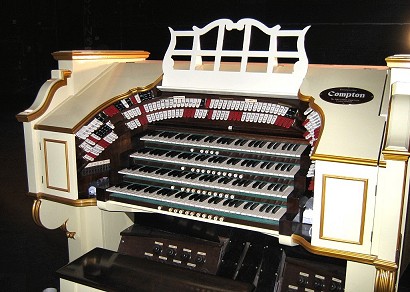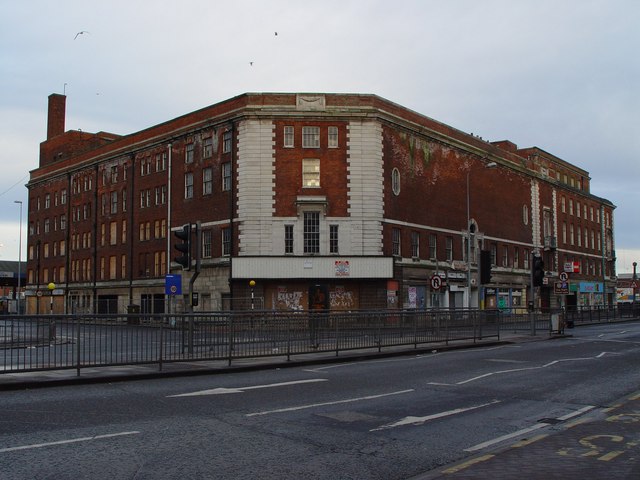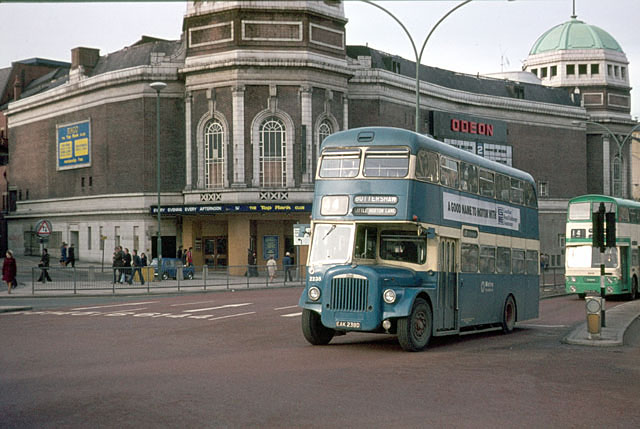|
Gaumont British
The Gaumont-British Picture Corporation was a British company that produced and distributed films and operated a cinema chain in the United Kingdom. It was established as an offshoot of France's Gaumont. Film production Gaumont-British was founded in 1898 as the British subsidiary of the French film studio Gaumont. In 1910, Gaumont Graphic Studios were at Shepherds Bush, in London. In 1914, the Gaumont-British film studios were opened, then completely rebuilt for sound, re-opening on 29 June 1932. "Gaumont Graphic newsreels were exhibited as part of larger cinema programmes from 1910 to 1932, when Gaumont Sound News was launched (superseded by Gaumont British News in 1934)." Gaumont's British subsidiary became independent of its French parent in 1922 when Isidore Ostrer acquired control of Gaumont-British. In 1927 the Ideal Film Company, a leading silent film maker, merged with Gaumont. The company's Lime Grove Studios was used for film productions, including Alfred Hi ... [...More Info...] [...Related Items...] OR: [Wikipedia] [Google] [Baidu] |
Gaumont (company)
Gaumont SA () is a French film and television production and distribution company headquartered in Neuilly-sur-Seine, France. Founded by the engineer-turned-inventor Léon Gaumont (1864–1946) in 1895, it is the oldest extant film company in the world, established before other studios such as Pathé (founded in 1896), Titanus (1904), Nordisk Film (1906), Universal Pictures, Universal, Paramount Pictures, Paramount, and Nikkatsu (all founded in 1912). Gaumont predominantly produces, co-produces, and distributes films, and in 2011, 95% of Gaumont's consolidated revenues came from the film division. The company is also a producer of TV series through Gaumont Télévision and animation through Gaumont Animation as well as its existing French production features. Gaumont is run by Nicolas Seydoux (chairman) and Sidonie Dumas (CEO). History Originally dealing in photographic apparatus, the company began producing short films in 1897 to promote its make of camera-projector. Léon Ga ... [...More Info...] [...Related Items...] OR: [Wikipedia] [Google] [Baidu] |
Gregory Motton
Gregory Motton (born September 1961) is a British playwright and author. Motton is best known for the originality of his formally demanding, largely a-political theatre plays at the Royal Court in the 1980s and 1990s, state of the nation satires in the 1990s, and later for his polemics about working class politics, ''A Working Class Alternative To Labour'' and ''Helping Themselves – The Left Wing Middle Classes In Theatre And The Arts''. He speaks fluent Swedish and is one of the chief translators of Strindberg's plays, known for his strict advocacy of translations rather than versions. Early life Gregory Motton was born in September 1961 in Wood Green, in the London borough of Enfield, the second child of Bernadette (née Clancy) from Rosscarbery in West Cork, Ireland, a bar-maid, and David Motton, of Tottenham, London, a writer of children's comics. He attended St. Angela's Convent, St. Paul's School, and Winchmore Comprehensive. Early career Motton's first two plays w ... [...More Info...] [...Related Items...] OR: [Wikipedia] [Google] [Baidu] |
John Compton (organ Builder)
John Haywood Compton (1876–1957) was an English pipe organ builder. His business based in Nottingham and London flourished between 1902 and 1965. Life John Compton was born in Newton Burgoland, Leicestershire, England on 20 June 1876. He was educated at King Edward's School, Birmingham, and then studied as an apprentice with Halmshaw & Sons in Birmingham. In 1898, he joined Brindley and Foster in Sheffield.. Then he joined Charles Lloyd in Nottingham. He set up the business of Musson & Compton in 1902 in Nottingham with James Frederick Musson. The partnership was dissolved in 1904. In 1919, the business moved to workshops at Turnham Green Terrace in Chiswick, London, which had been vacated by August Gern. He occupied a new factory at Chase Road in Park Royal, North Acton, London in 1930. Compton worked primarily on electric-action pipe organs and electronic organs. His first electronic instrument was the Melotone, a solo voice added to theatre organs, followed by the Th ... [...More Info...] [...Related Items...] OR: [Wikipedia] [Google] [Baidu] |
Shepherd's Bush
Shepherd's Bush is a suburb of West London, England, within the London Borough of Hammersmith and Fulham west of Charing Cross, and identified as a major metropolitan centre in the London Plan. Although primarily residential in character, its focus is the shopping area of Shepherd's Bush Green, with the Westfield London shopping centre a short distance to the north. The main thoroughfares are Uxbridge Road, Goldhawk Road and Askew Road, all with small and mostly independent shops, pubs and restaurants. Loftus Road football stadium in Shepherd's Bush is home to Queens Park Rangers. In 2011, the population of the area was 39,724. The district is bounded by Hammersmith to the south, Holland Park and Notting Hill to the east, Harlesden and Kensal Green to the north and by Acton, London, Acton and Chiswick to the west. White City, London, White City forms the northern part of Shepherd's Bush. Shepherd's Bush comprises the Shepherd's Bush Green, Askew, College Park & Old Oak, and Wo ... [...More Info...] [...Related Items...] OR: [Wikipedia] [Google] [Baidu] |
Theatre Organ
A theatre organ (also known as a theater organ, or, especially in the United Kingdom, a cinema organ) is a type of pipe organ developed to accompany silent films from the 1900s to the 1920s. Theatre organs have horseshoe-shaped arrangements of stop tabs (tongue-shaped switches) above and around the instrument's keyboards on their organ console, consoles. Theatre organ consoles were typically decorated with brightly colored stop tabs, with built-in console lighting. Organs in the UK had a common feature: large translucent surrounds extending from both sides of the console, with internal colored lighting. Theatre organs began to be installed in other venues, such as civic auditoriums, sports arenas, private residences, and churches. Though there are few original instruments, hundreds of theatre pipe organs are installed in public venues throughout the world today, while many more exist in private residences. History Originally, films were accompanied by Pit orchestra, pit orchest ... [...More Info...] [...Related Items...] OR: [Wikipedia] [Google] [Baidu] |
William Morton (theatre Manager)
William Morton (24 January 1838 – 5 July 1938) was an amusement caterer, a theatre and cinema manager in England for 70 years. After an erratic start in Southport, Morton's career stabilised when he took on struggling illusionists Maskelyne and Cooke. He developed their careers, managed them for sixteen years, established them in the heart of London and presented them by Royal Command for Prince George's 14th birthday. For sixteen years he was manager of the Greenwich Theatre where he further speculated, developing theatrical businesses in southeast London and the provinces. In his sixties, he moved north to Hull where he established new companies, developed and built both theatres and cinemas. From 1920 onwards he was interviewed each birthday at his office by the local press who dubbed him the Grand Old Man of Hull. Morton had become an observer and commentator on a century of English life and entertainments. Morton contributed to the development of Victorian entertainments ... [...More Info...] [...Related Items...] OR: [Wikipedia] [Google] [Baidu] |
Closed Cinemas In Kingston Upon Hull
In 1898 William Morton's Theatre Royal showed a ' Veriscope' film, probably the first time any film was shown in a Hull theatre. The Prince's Hall was the first purpose-built cinema in Kingston upon Hull, and was opened in George Street by Morton in 1910 (renamed the Curzon 1955). As Hull embraced the new age of public entertainment, attendances at traditional theatre declined. Luxurious cinemas, taking their inspiration from theatres and music halls, were built to accommodate audiences in almost every neighbourhood in the city. By 1914, there were 29 cinemas, theatres and halls showing films in the city. The London and Provincial Cinema Company owned the Hippodrome; the National Electric Picture Theatres owned the Theatre de Luxe, but Morton's was the largest and most influential cinema chain in Hull. Since 1895, Morton had been a leading light in theatre and then, from 1910, also cinema. However, in 1935, with decline in theatre going, his long reign and businesses came to an e ... [...More Info...] [...Related Items...] OR: [Wikipedia] [Google] [Baidu] |
Kilburn, London
Kilburn is an area in North West London, North West London, in the London Borough of Camden, London Boroughs of Camden, London Borough of Brent, Brent and the City of Westminster. Kilburn High Road railway station lies 3.5 miles (5.6 km) north-west of Charing Cross. Kilburn developed from a linear hamlet that grew up on ancient Watling Street (the modern A5 Road), the hamlet took its name from Kilburn Priory, which was built on the banks of Kilburn Brook. Watling Street forms the contemporary boundary between the boroughs of Brent and Camden. The area has London's highest Irish people, Irish population, as well as a sizable British Afro-Caribbean community, Afro-Caribbean population, and was once home to the black civil rights leader Billy Strachan. Geographic and administrative context Kilburn has never been an administrative unit and has therefore never had any formally defined boundaries. The area, which took its name from a nearby watercourse and eponymous priory, dev ... [...More Info...] [...Related Items...] OR: [Wikipedia] [Google] [Baidu] |
Gaumont State Cinema
Gaumont State Cinema is a Grade II* listed Art Deco theatre located in Kilburn, a district in northwest London. Building Designed by George Coles and commissioned and built by Phillip and Sid Hyams, the cinema opened in 1937. The ''Gaumont State'' was one of the biggest auditoria in Europe, with seating for 4,004 people. The name ''State'' is said to come from the huge tower, inspired by the Empire State Building in New York City. The exterior of the cinema is designed in an Art Deco Italian Renaissance style, covered in cream ceramic tiles. The tower, designed in the style of a 1930s New York skyscraper, can be seen for miles around, and bears the name "STATE" in large red neon letters. The interior was designed in the opulent style of cinemas of the day, and includes a Wurlitzer organ which is today one of the largest fully functioning Wurlitzer organs in Britain. It is also one of the few cinema organs remaining in their original locations. History Entertainers Gracie Fie ... [...More Info...] [...Related Items...] OR: [Wikipedia] [Google] [Baidu] |
Manchester
Manchester () is a city and the metropolitan borough of Greater Manchester, England. It had an estimated population of in . Greater Manchester is the third-most populous metropolitan area in the United Kingdom, with a population of 2.92 million, and the largest in Northern England. It borders the Cheshire Plain to the south, the Pennines to the north and east, and the neighbouring city of Salford to the west. The city borders the boroughs of Trafford, Metropolitan Borough of Stockport, Stockport, Tameside, Metropolitan Borough of Oldham, Oldham, Metropolitan Borough of Rochdale, Rochdale, Metropolitan Borough of Bury, Bury and City of Salford, Salford. The history of Manchester began with the civilian settlement associated with the Roman fort (''castra'') of Mamucium, ''Mamucium'' or ''Mancunium'', established on a sandstone bluff near the confluence of the rivers River Medlock, Medlock and River Irwell, Irwell. Throughout the Middle Ages, Manchester remained a ma ... [...More Info...] [...Related Items...] OR: [Wikipedia] [Google] [Baidu] |
Bradford
Bradford is a city status in the United Kingdom, city in West Yorkshire, England. It became a municipal borough in 1847, received a city charter in 1897 and, since the Local Government Act 1972, 1974 reform, the city status in the United Kingdom, city status has belonged to the larger City of Bradford metropolitan borough. It had a population of 349,561 at the 2011 Census for England and Wales, 2011 census, making it the second-largest subdivision of the West Yorkshire Built-up Area after Leeds, which is approximately to the east. The borough had a population of , making it the List of English districts by population, most populous district in England. Historic counties of England, Historically part of the West Riding of Yorkshire, the city grew in the 19th century as an international centre of Textile manufacture during the Industrial Revolution, textile manufacture, particularly wool. It was a boomtown of the Industrial Revolution, and amongst the earliest Industrialisation, ... [...More Info...] [...Related Items...] OR: [Wikipedia] [Google] [Baidu] |
Bradford Odeon
Bradford Odeon is the name applied to two different cinemas in central Bradford, West Yorkshire, England. One, in Godwin Street, was built in 1930 and survives; the other, in Manchester Road, was built in 1938 and demolished in 1969. Godwin Street building The cinema, originally built as a 3,318 seat cine-variety theatre, was the largest outside London, and the third largest in England. It was completed in 1930 as the New Victoria. It is on the site of William Whittaker's brewery and malting, which had closed in 1928. It is a Renaissance Revival building designed by the architect William Illingworth, with copper-covered cupolas on two corners complementing those on the neighbouring Bradford Alhambra theatre. The New Victoria combined a 3,318-seat auditorium, ballroom and 200-seat restaurant. The auditorium was primarily a cinema, but also a concert and ballet venue with a stage, orchestra pit, Wurlitzer organ and excellent acoustics. As a cinema it was the third largest i ... [...More Info...] [...Related Items...] OR: [Wikipedia] [Google] [Baidu] |







